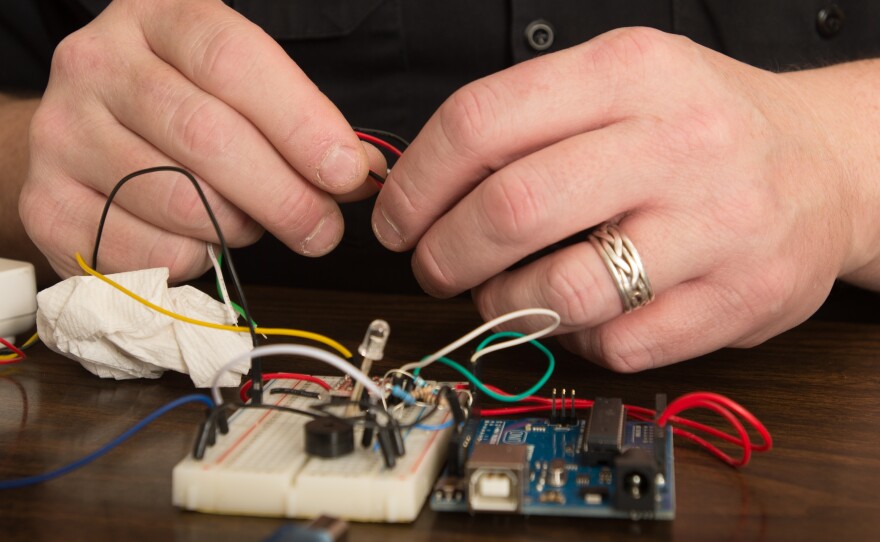Anyone who walked by Professor Thomas Asmuth’s office on the University of West Florida Pensacola Campus recently might have heard intermittent beeps and seen flashes of light as he worked on one of his projects that merges science and art.
Art is often defined as an item produced in a visual form, such as a painting or sculpture. Asmuth, an assistant professor in digital and experimental media, stretches the traditional definition of art, blending disciplines to explore human creative skill and imagination. He embraces the ever-expanding fields of science and technology and finds inspiration and fodder for creation in various processes, be it audio, video or the intricacies of devices that react to sensory input. Asmuth explores their place in our ever-evolving culture.
One of his recent endeavors garnered a fellowship to Signal Culture, an organization in Owego, N.Y., whose members encourage creation in the field of experimental media art by creating an environment in which artists, toolmakers, curators, critics, and art historians who are contributing to the field have time and space to make new work and to interact with each other. In addition to its residency program, Signal Culture organizes public exhibitions and produces resources for researchers and practitioners.
“We have an open call process, and we receive applications from around the world,” said Debora Bernagozzi, one of the founders of the program. “We chose Thomas because he is doing excellent work with brain wave sensors. He isn’t re-hashing something. He is getting into code to find out just what technology can really do.”
Mike O’Neal, an artist and the spokesman for Artel Gallrey in downtown Pensacola, is familiar with Asmuth’s work. O’Neal and Bernagozzi agree that one of Asmuth’s many strengths as an artist and scientist is his willingness to try new things.
“Artists tend to grab tools and experiment. If you are a passenger in a car, you can observe, but you have to be in the driver’s seat to learn the skill,” O’Neal said. “Given the age we are living in, people in new media are exploring the point at which technology and traditional artistic methods merge. Asmuth is thinking about process in a formal way.”
By donning a portable headset and hooking himself up to an electroencephalogram (EEG), Asmuth explores. The machine tracks brain wave patterns and sends them to a computer that records the results in ever-changing levels of intensity of light.
“One of the most popular ideas out there right now is the quantified self,” Asmuth said.
“I am quantizing the electrical activity in my body… I am doing this right now. Other people are tracking how many steps they took, or their current heart rate to train. I think we can go past just personal training and use technology as a different type of interface to make creative, expressive works that are just about the human condition right now and what we are doing with our tools and what we are thinking about.”
Though Asmuth’s explorations are in the nascent stages, he wants to go beyond manipulating the intensity of light. His consultations with expert on biofeedback confirm that people can train themselves to do simple tasks.
“What if this was tapped in now to the cellphone or the WIFI network and there is an object somewhere that was currently tracking me and outputting some sort of expressive idea or form,” he asked.
Students who take Asmuth’s classes marvel at the variety and voracity of his interests, which he can explain in the context of the work of the late experimental musician, John Cage.
“A lot of my work is more related to performance,” Asmuth said. “It’s about the atmosphere, it’s about who is there, who has a nervous cough. It’s about the space … I like to work collaboratively … My ideas are a lot more in those sorts of directions. I really respect craft and skill, and I try to go for that… but that’s not where it ends for me. My work is about trying to grab some sort of idea, or be a remnant of an idea.”
Asmuth earned a BFA from the San Francisco Art Institute in 2000 and is an alumnus of the Cadre Laboratory for New Media at San Jose State University, where he received an MFA in 2009.
This article is part of a collaboration between WUWF and the UWF Center for Research and Economic Opportunity.








